High-Performance Flexible PLA/BTO-Based Pressure Sensor for Motion Monitoring and Human–Computer Interaction
Abstract
:1. Introduction
2. Materials and Methods
2.1. Materials
2.2. Preparation of PLA/BTO Piezoelectric Nanocomposite Films
2.3. Fabrication of PPS Based on PLA/BTO Membranes
3. Results
3.1. Material Characterization, Preparation, and Characterization of Thin Films
3.2. Electrical Properties of the PLA/BTO Nanocomposite Films
3.3. The Mechanism of Electrical Signal Output Enhancement
3.4. Electrical Properties of the PLA/BTO Tetragonal Nanocomposite Films
3.5. Applications of PPSBT
4. Conclusions
Supplementary Materials
Author Contributions
Funding
Institutional Review Board Statement
Informed Consent Statement
Data Availability Statement
Conflicts of Interest
References
- Chi, G.; Gong, W.; Xiao, G.; Pan, J.; Chen, J.; Su, L.; Fugetsu, B.; Sakata, I.; Zhang, X. Wire-shaped, all-solid-state, high-performance flexible asymmetric supercapacitors based on (Mn, Fe) oxides/reduced graphene oxide/oxidized carbon nanotube fiber hybrid electrodes. Nano Energy 2023, 117, 108887. [Google Scholar] [CrossRef]
- Li, W.; Zhu, A.; Gu, H.; Wang, B.; Wang, G.; Li, S.; Chen, S.; Liao, J.; Xing, G. Co-passivation of perovskite film towards stable and efficient perovskite solar cell. Chem. Eng. J. 2023, 471, 144561. [Google Scholar] [CrossRef]
- Huang, F.; Hu, J.; Yan, X. A wide-linear-range and low-hysteresis resistive strain sensor made of double-threaded conductive yarn for human movement detection. J. Mater. Sci. Technol. 2024, 172, 202–212. [Google Scholar] [CrossRef]
- Yu, W.; Yao, N.; Pan, J.; Fang, W.; Li, X.; Tong, L.; Zhang, L. Highly sensitive and fast response strain sensor based on evanescently coupled micro/nanofibers. Opto-Electron. Adv. 2022, 5, 210101. [Google Scholar] [CrossRef]
- Cai, H.; Zhang, D.; Zhang, H.; Tang, M.; Xu, Z.; Xia, H.; Li, K.; Wang, J. Trehalose-enhanced ionic conductive hydrogels with extreme stretchability, self-adhesive and anti-freezing abilities for both flexible strain sensor and all-solid-state supercapacitor. Chem. Eng. J. 2023, 472, 144849. [Google Scholar] [CrossRef]
- Zhang, L.; Zhang, X.; Xu, L.; Wang, D.; Lu, X.; Zhang, A. Semi-embedded robust MXene/AgNW sensor with self-healing, high sensitivity and a wide range for motion detection. Chem. Eng. J. 2022, 434, 134751. [Google Scholar] [CrossRef]
- Yin, M.; Liu, T.; Li, T.; Guan, Z.; Zhang, K.; Yin, S.; Gou, G.; Sun, J.; Ma, T.; Cheng, J.; et al. Development of the force detecting liner for total knee arthroplasty. IEEE Sens. J. 2023, 23, 10342–10349. [Google Scholar] [CrossRef]
- Xu, M.; Zhang, Q.; Tan, Q.; Zhang, W.; Sang, S.; Yang, K.; Ge, Y. A magnetostrictive BaTiO3-Fe-Ga & PDMS magnetic field sensor: Research on magnetic detection performance. Sens. Actuator A Phys. 2022, 335, 113383. [Google Scholar] [CrossRef]
- Yang, M.; Cheng, Y.; Yue, Y.; Chen, Y.; Gao, H.; Li, L.; Cai, B.; Liu, W.; Wang, Z.; Guo, H.; et al. High-performance flexible pressure sensor with a self-healing function for tactile feedback. Adv. Sci. 2022, 9, 2200507. [Google Scholar] [CrossRef]
- Zhang, Z.; Gui, X.; Hu, Q.; Yang, L.; Yang, R.; Huang, B.; Yang, B.; Tang, Z. Highly sensitive capacitive pressure sensor based on a micropyramid array for health and motion monitoring. Adv. Electron. Mater. 2021, 7, 2100174. [Google Scholar] [CrossRef]
- Lu, X.; Lin, R.; Zhu, S.; Lin, Z.; Song, X.; Huang, F.; Zheng, W. Ultralarge elastic deformation (180° Fold) of Cubic-natBP microwires for wearable flexible strain sensors. ACS Mater. Lett. 2023, 5, 2282–2291. [Google Scholar] [CrossRef]
- Han, J.; Kim, D.B.; Kim, J.H.; Kim, S.W.; Ahn, B.U.; Cho, Y.S. Origin of high piezoelectricity in carbon nanotube/halide nanocrystal/P(VDF-TrFE) composite nanofibers designed for bending-energy harvesters and pressure sensors. Nano Energy 2022, 99, 107421. [Google Scholar] [CrossRef]
- Su, C.; Huang, X.; Zhang, L.; Zhang, Y.; Yu, Z.; Chen, C.; Ye, Y.; Guo, S. Robust superhydrophobic wearable piezoelectric nanogenerators for self-powered body motion sensors. Nano Energy 2023, 107, 108095. [Google Scholar] [CrossRef]
- Hong, S.H.; Chen, T.; Wang, G.; Popovic, S.M.; Filleter, T.; Naguib, H.E. Room-temperature self-healing polysiloxane networks for highly sensitive piezoresistive pressure sensor with microdome structures. Chem. Eng. J. 2023, 471, 144429. [Google Scholar] [CrossRef]
- Kim, T.; Kim, G.; Kim, H.; Yoon, H.J.; Kim, T.; Jun, Y.; Shin, T.; Kang, S.; Cheon, J.; Hwang, D.; et al. Megahertz-wave-transmitting conducting polymer electrode for device-to-device integration. Nat. Commun. 2019, 10, 653. [Google Scholar] [CrossRef]
- Liu, J.; Wen, Z.; Lei, H.; Gao, Z.; Sun, X. A liquid–solid interface-based triboelectric tactile sensor with ultrahigh sensitivity of 21.48 kPa−1. Nano-Micro Lett. 2022, 14, 88. [Google Scholar] [CrossRef]
- Xu, L.; Zhang, Y.; Jiang, H.; Zhang, N.; Xiong, R.; Zhang, H. Solvent selective effect occurs in iodinated adamantanone ferroelectrics. Adv. Sci. 2022, 9, 2201702. [Google Scholar] [CrossRef]
- Liu, J.; Gao, X.; Jin, H.; Ren, K.; Guo, J.; Qiao, L.; Qiu, C.; Chen, W.; He, Y.; Dong, S.; et al. Miniaturized electromechanical devices with multi-vibration modes achieved by orderly stacked structure with piezoelectric strain units. Nat. Commun. 2022, 13, 6567. [Google Scholar] [CrossRef]
- Chen, C.; Zhao, S.; Pan, C.; Zi, Y.; Wang, F.; Yang, C.; Wang, Z.L. A method for quantitatively separating the piezoelectric component from the as-received “Piezoelectric” signal. Nat. Commun. 2022, 13, 1391. [Google Scholar] [CrossRef]
- Shojafar, M.; Mukherjee, M.; Piuri, V.; Abawajy, J. Guest editorial: Security and privacy of federated learning solutions for industrial IoT applications. IEEE Trans. Industr. Inform. 2022, 18, 3519–3521. [Google Scholar] [CrossRef]
- Pal, R.; Yadav, S.; Karnwal, R.; Aarti. EEWC: Energy-efficient weighted clustering method based on genetic algorithm for HWSNs. Complex Intell. Syst. 2020, 6, 391–400. [Google Scholar] [CrossRef]
- Han, L.; Zeng, W.; Dong, Y.; Wang, X.; Lin, L. Mapping and simultaneous detection of arterial and venous pulses using large-scale high-density flexible piezoelectret sensor array. Adv. Electron. Mater. 2022, 8, 2200012. [Google Scholar] [CrossRef]
- Suo, J.; Liu, Y.; Wu, C.; Chen, M.; Huang, Q.; Liu, Y.; Yao, K.; Chen, Y.; Pan, Q.; Chang, X.; et al. Wide-bandwidth nanocomposite-sensor integrated smart mask for tracking multiphase respiratory activities. Adv. Sci. 2022, 9, 2203565. [Google Scholar] [CrossRef] [PubMed]
- Shawon, S.M.A.Z.; Carballo, Z.D.; Vega, V.S.; Lin, C.; Rafaqut, M.S.; Sun, A.X.; Li, J.J.; Uddin, M.J. Surface modified hybrid ZnSnO3 nanocubes for enhanced piezoelectric power generation and wireless sensory application. Nano Energy 2022, 92, 106653. [Google Scholar] [CrossRef]
- Lee, D.G.; Shin, J.; Kim, H.S.; Hur, S.; Sun, S.; Jang, J.S.; Chang, S.; Jung, I.; Nahm, S.; Kang, H.; et al. Autonomous resonance-tuning mechanism for environmental adaptive energy harvesting. Adv. Sci. 2023, 10, 2205179. [Google Scholar] [CrossRef]
- Zhao, Y.; Li, X.; Hou, N.; Yuan, T.; Huang, S.; Li, L.; Li, X.; Zhang, W. Self-powered sensor integration system based on thorn-like polyaniline composites for smart home applications. Nano Energy 2022, 104, 107966. [Google Scholar] [CrossRef]
- Fu, R.; Zhong, X.; Xiao, C.; Lin, J.; Guan, Y.; Tian, Y.; Zhou, Z.; Tan, G.; Hu, H.; Zhou, L.; et al. A stretchable, biocompatible, and self-powered hydrogel multichannel wireless sensor system based on piezoelectric barium titanate nanoparticles for health monitoring. Nano Energy 2023, 114, 108617. [Google Scholar] [CrossRef]
- Jin, L.; Liu, Z.; Altintas, M.; Zheng, Y.; Liu, Z.; Yao, S.; Fan, Y.; Li, Y. Wearable piezoelectric airflow transducers for human respiratory and metabolic monitoring. ACS Sens. 2022, 7, 2281–2292. [Google Scholar] [CrossRef]
- Mondal, S.; Poddar, S.; Bhattacharjee, S.; Maiti, S.; Banerjee, A.; Chattopadhyay, K.K. Lead free halide perovskite embedded PVDF based efficient mechanical energy harvester: Self-driven respiratory sensor. Nano Energy 2023, 115, 108689. [Google Scholar] [CrossRef]
- Achour, M.A.B.; Rguiti, M.; Samuel, C.; Barrau, S.; Lacrampe, M.F.; Courtois, C. Energy harvesting by uniaxially-stretched poly (lactide) films at low tensile strain frequencies for powering wearable sensors: Experimental results and theoretical extrapolation. Smart Mater. Struct. 2023, 32, 075009. [Google Scholar] [CrossRef]
- Le, T.T.; Curry, E.J.; Vinikoor, T.; Das, R.; Liu, Y.; Sheets, D.; Tran, K.T.M.; Hawxhurst, C.J.; Stevens, J.N.; Bilal, O.R.; et al. Piezoelectric nanofiber membrane for reusable, stable, and highly functional face mask filter with long-term biodegradability. Adv. Funct. Mater. 2022, 32, 2113040. [Google Scholar] [CrossRef]
- Li, L.; Peng, F.; Zheng, G.; Dai, K.; Liu, C.; Shen, C. Electrospun core–sheath PVDF piezoelectric fiber for sensing application. ACS Appl. Mater. Interfaces 2023, 15, 15938–15945. [Google Scholar] [CrossRef] [PubMed]
- Min, S.; Kim, D.H.; Joe, D.J.; Kim, B.W.; Jung, Y.H.; Lee, J.H.; Lee, B.Y.; Doh, I.l.; An, J.; Youn, Y.N.; et al. Clinical validation of a wearable piezoelectric blood-pressure sensor for continuous health monitoring. Adv. Mater. 2023, 35, 2301627. [Google Scholar] [CrossRef]
- Li, R.J.; Wei, W.X.; Hai, J.L.; Gao, L.X.; Gao, Z.W.; Fan, Y.Y. Preparation and electric-field response of novel tetragonal barium titanate. J. Alloys Compd. 2013, 574, 212–216. [Google Scholar] [CrossRef]
- Pezzotti, G.; Matsutani, A.; Zhu, W. Spectroscopic assessments of domain texture in barium titanate: I. confocal Raman polarization analysis. J. Am. Ceram. Soc. 2010, 93, 256–264. [Google Scholar] [CrossRef]
- Lee, H.W.; Moon, S.; Choi, C.H.; Kim, D.K. Synthesis and size control of tetragonal barium titanate nanopowders by facile solvothermal method. J. Am. Ceram. Soc. 2012, 95, 2429–2434. [Google Scholar] [CrossRef]
- Li, A.; Ge, C.; Lü, P.; Wu, D.; Xiong, S.; Ming, N. Fabrication and electrical properties of sol-gel derived BaTiO3 films with metallic LaNiO3 electrode. Appl. Phys. Lett. 1997, 70, 1616–1618. [Google Scholar] [CrossRef]
- Huang, S.; Li, H.; Jiang, S.; Chen, X.; An, L. Crystal structure and morphology influenced by shear effect of poly (l-lactide) and its melting behavior revealed by WAXD, DSC and in-situ POM. Polymer 2011, 52, 3478–3487. [Google Scholar] [CrossRef]
- Shi, S.; Pan, Z.; Cheng, Y.; Zhai, Y.; Zhang, Y.; Ding, X.; Liu, J.; Zhai, J.; Xu, J. Three-dimensional polypyrrole induced high-performance flexible piezoelectric nanogenerators for mechanical energy harvesting. Compos. Sci. Technol. 2022, 219, 109260. [Google Scholar] [CrossRef]
- Wang, P.; Xiong, Z.; Xiong, H.; Cai, J. Synergistic effects of modified TiO2/multifunctionalized graphene oxide nanosheets as functional hybrid nanofiller in enhancing the interface compatibility of PLA/starch nanocomposites. J. Appl. Polym. Sci. 2020, 137, 49094. [Google Scholar] [CrossRef]
- Gong, X.; Tang, C.Y.; Pan, L.; Hao, Z.; Tsui, C.P. Characterization of poly (vinyl alcohol)(PVA)/ZnO nanocomposites prepared by a one-pot method. Compos. B Eng. 2014, 60, 144–149. [Google Scholar] [CrossRef]
- Wang, L.; Wang, J.; Ye, C.; Wang, K.; Zhao, C.; Wu, Y.; He, Y. Photodeposition of CoOx nanoparticles on BiFeO3 nanodisk for efficiently piezocatalytic degradation of rhodamine B by utilizing ultrasonic vibration energy. Ultrason. Sonochem. 2021, 80, 105813. [Google Scholar] [CrossRef] [PubMed]
- Park, K.I.; Lee, M.; Liu, Y.; Moon, S.; Hwang, G.T.; Zhu, G.; Kim, J.E.; Kim, S.O.; Kim, D.K.; Wang, Z.L.; et al. Flexible nanocomposite generator made of BaTiO3 nanoparticles and graphitic carbons. Adv. Mater. 2012, 24, 2999–3004. [Google Scholar] [CrossRef] [PubMed]
- Zhang, J.L.; Ji, P.F.; Wu, Y.Q.; Zhao, X.; Tan, Y.Q.; Wang, C.L. Strong piezoelectricity exhibited by large-grained BaTiO3 ceramics. Appl. Phys. Lett. 2014, 104, 222909. [Google Scholar] [CrossRef]
- Luo, C.; Hu, S.; Xia, M.; Li, P.; Hu, J.; Li, G.; Jiang, H.; Zhang, W. A flexible lead-free BaTiO3/PDMS/C composite nanogenerator as a piezoelectric energy harvester. Energy Technol. 2018, 6, 922–927. [Google Scholar] [CrossRef]
- Wu, J.; Qin, N.; Bao, D. Effective enhancement of piezocatalytic activity of BaTiO3 nanowires under ultrasonic vibration. Nano Energy 2018, 45, 44–51. [Google Scholar] [CrossRef]
- Prateek; Thakur, V.K.; Gupta, R.K. Recent progress on ferroelectric polymer-based nanocomposites for high energy density capacitors: Synthesis, dielectric properties, and future aspects. Chem. Rev. 2016, 116, 4260–4317. [Google Scholar] [CrossRef] [PubMed]
- Dang, Z.M.; Yuan, J.K.; Zha, J.W.; Zhou, T.; Li, S.T.; Hu, G.H. Fundamentals, processes and applications of high-permittivity polymer–matrix composites. Prog. Mater. Sci. 2012, 57, 660–723. [Google Scholar] [CrossRef]
- Dang, Z.M.; Wang, L.; Yin, Y.I.; Zhang, Q.; Lei, Q.Q. Giant dielectric permittivities in functionalized carbon-nanotube/electroactive-polymer nanocomposites. Adv. Mater. 2007, 19, 852–857. [Google Scholar] [CrossRef]
- Guo, J.; Fu, P.; Qiu, Z.; Chen, C.; Wang, S.; Zhang, K.; Zhang, X.; Qiao, X.; Zhao, W.; Zhao, H.; et al. PA1111/BaTiO3 nanocomposites with surprisingly enhanced piezoelectricity at low filler content via in-situ compositing process. Compos. Sci. Technol. 2021, 209, 108796. [Google Scholar] [CrossRef]
- Hanani, Z.; Izanzar, I.; Merselmiz, S.; El Assimi, T.; Mezzane, D.; Amjoud, M.; Uršič, H.; Prah, U.; Ghanbaja, J.; Saadoune, I.; et al. A flexible self-poled piezocomposite nanogenerator based on H2(Zr0.1Ti0.9)3O7 nanowires and polylactic acid biopolymer. Sustain. Energy Fuels 2022, 6, 1983–1991. [Google Scholar] [CrossRef]
- Yu, X.; Wang, H.; Ning, X.; Sun, R.; Albadawi, H.; Salomao, M.; Silva, A.C.; Yu, Y.; Tian, L.; Koh, A.; et al. Needle-shaped ultrathin piezoelectric microsystem for guided tissue targeting via mechanical sensing. Nat. Biomed. Eng. 2018, 2, 165–172. [Google Scholar] [CrossRef] [PubMed]
- Li, Y.; Cao, W.; Liu, Z.; Zhang, Y.; Chen, Z.; Zheng, X. A personalized electronic textile for ultrasensitive pressure sensing enabled by biocompatible MXene/PEDOT: PSS composite. Carbon Energy 2024, 6, e530. [Google Scholar] [CrossRef]
- Jeronimo, K.; Koutsos, V.; Cheung, R.; Mastropaolo, E. PDMS-ZnO piezoelectric nanocomposites for pressure sensors. Sensors 2021, 21, 5873. [Google Scholar] [CrossRef]
- Guess, M.; Soltis, I.; Rigo, B.; Zavanelli, N.; Kapasi, S.; Kim, H.; Yeo, W.H. Wireless batteryless soft sensors for ambulatory cardiovascular health monitoring. Soft Sci. 2023, 3, 24. [Google Scholar] [CrossRef]
- Kim, N.I.; Lee, J.M.; Moradnia, M.; Chen, J.; Pouladi, S.; Yarali, M.; Kim, J.Y.; Kwon, M.K.; Lee, T.R.; Ryou, J.H. Biocompatible composite thin-film wearable piezoelectric pressure sensor for monitoring of physiological and muscle motions. Soft Sci. 2022, 2, 8. [Google Scholar] [CrossRef]
- Xiong, Y.; Liu, Z.; Zhao, Z.; Xu, Y.; Wan, Y.; Zhu, P.; Hu, Y.; Sun, R. A template-stripped carbon nanofiber/poly(styrene-butadiene-styrene) compound for high-sensitivity pressure and strain sensing. Soft Sci. 2022, 2, 14. [Google Scholar] [CrossRef]
- Zheng, X.; Zhang, S.; Zhou, M.; Lu, H.; Guo, S.; Zhang, Y.; Li, C.; Tan, S.C. MXene functionalized, highly breathable and sensitive pressure sensors with multi-layered porous structure. Adv. Funct. Mater. 2023, 33, 2214880. [Google Scholar] [CrossRef]
- Li, G.; Guo, C.F. PEDOT: PSS-based intrinsically soft and stretchable bioelectronics. Soft Sci. 2022, 2, 7. [Google Scholar] [CrossRef]
- Li, L.; Pan, J.; Chang, L.; Liu, Z.; Wu, G.; Hu, Y. A MXene heterostructure-based piezoionic sensor for wearable sensing applications. Chem. Eng. J. 2024, 482, 148988. [Google Scholar] [CrossRef]
- Wang, G.; Wang, Z.; Wu, Y.; Luo, Y.; Tan, Q.; Zhao, L.; Sun, D.; Wu, D. A robust stretchable pressure sensor for electronic skins. Org. Electron. 2020, 86, 105926. [Google Scholar] [CrossRef]
- Du, Y.; Wang, R.; Zeng, M.; Xu, S.; Saeidi-Javash, M.; Wu, W.; Zhang, Y. Hybrid printing of wearable piezoelectric sensors. Nano Energy 2021, 90, 106522. [Google Scholar] [CrossRef]
- Kim, H.; Kim, G.; Kim, T.; Lee, S.; Kang, D.; Hwang, M.S.; Chae, Y.; Kang, S.; Lee, H.; Park, H.G.; et al. Transparent, flexible, conformal capacitive pressure sensors with nanoparticles. Small 2018, 14, 1703432. [Google Scholar] [CrossRef] [PubMed]
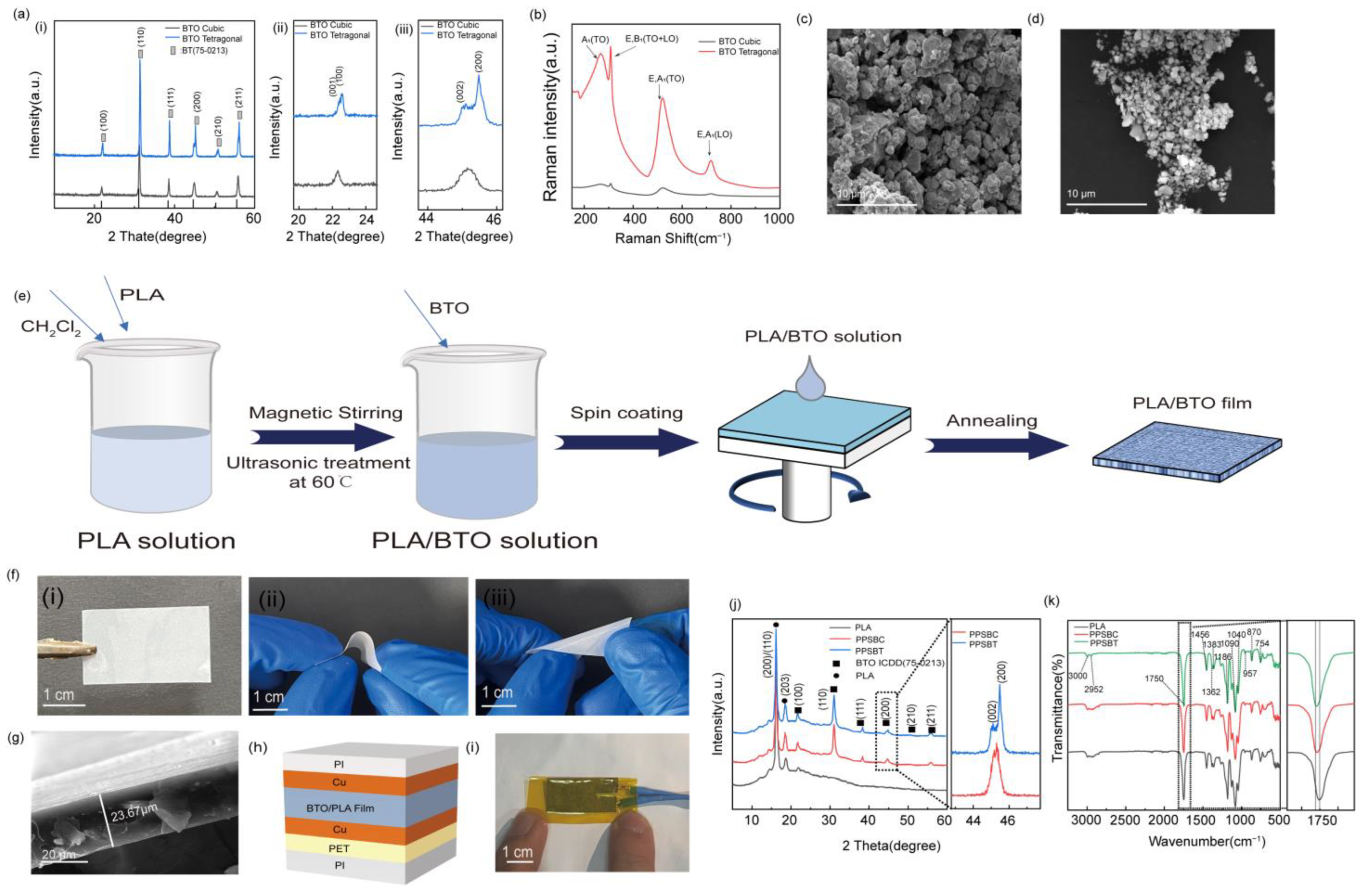
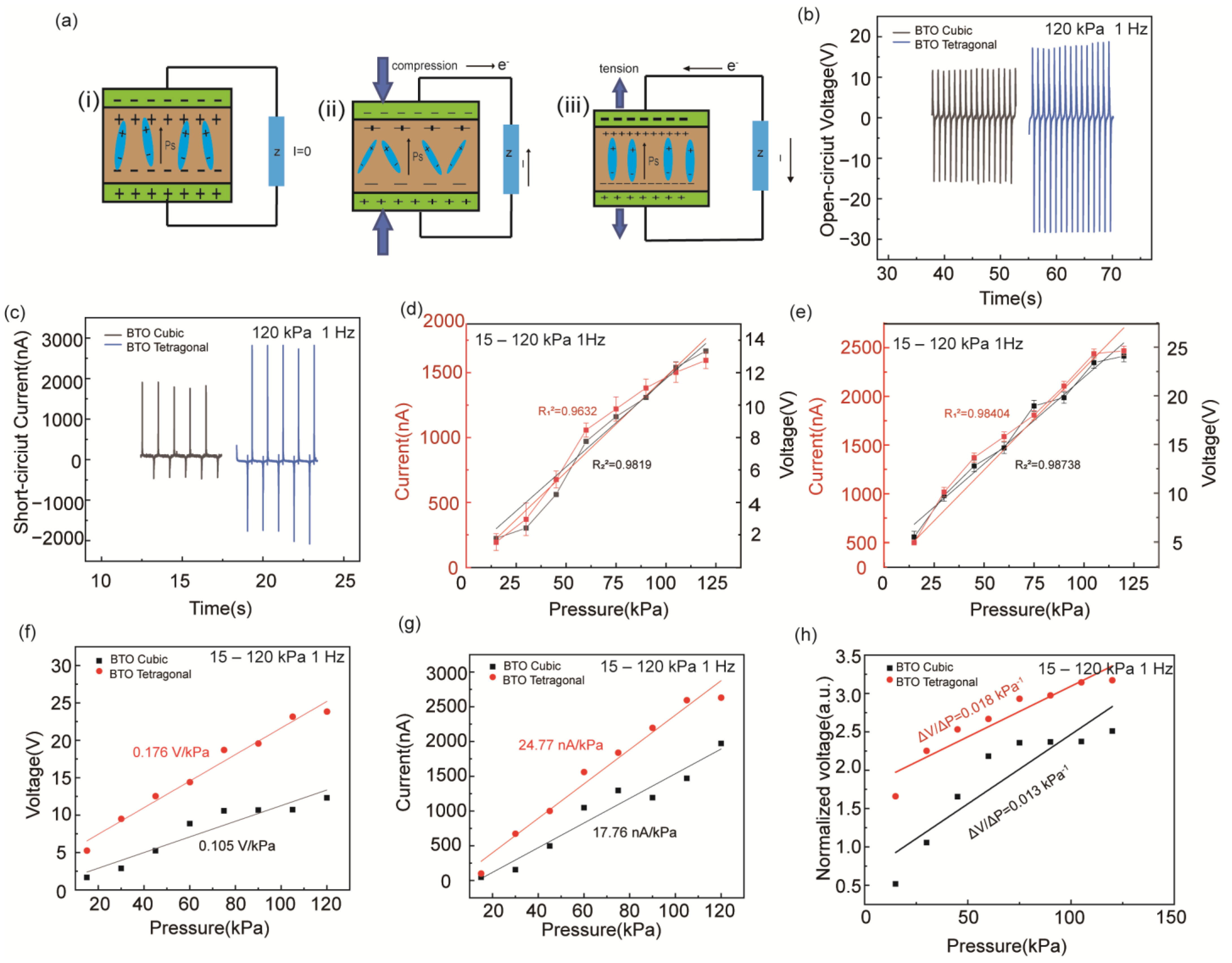
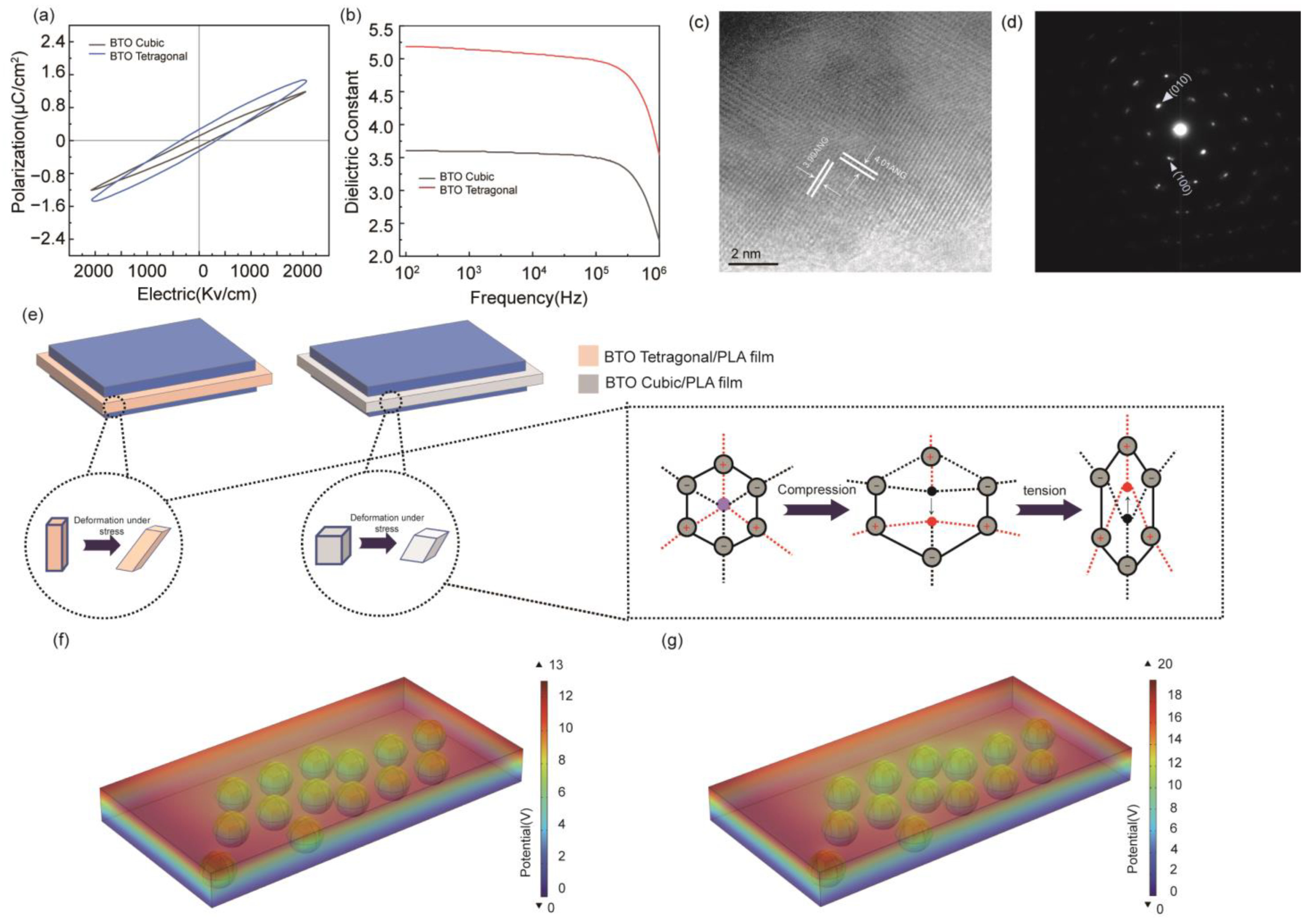

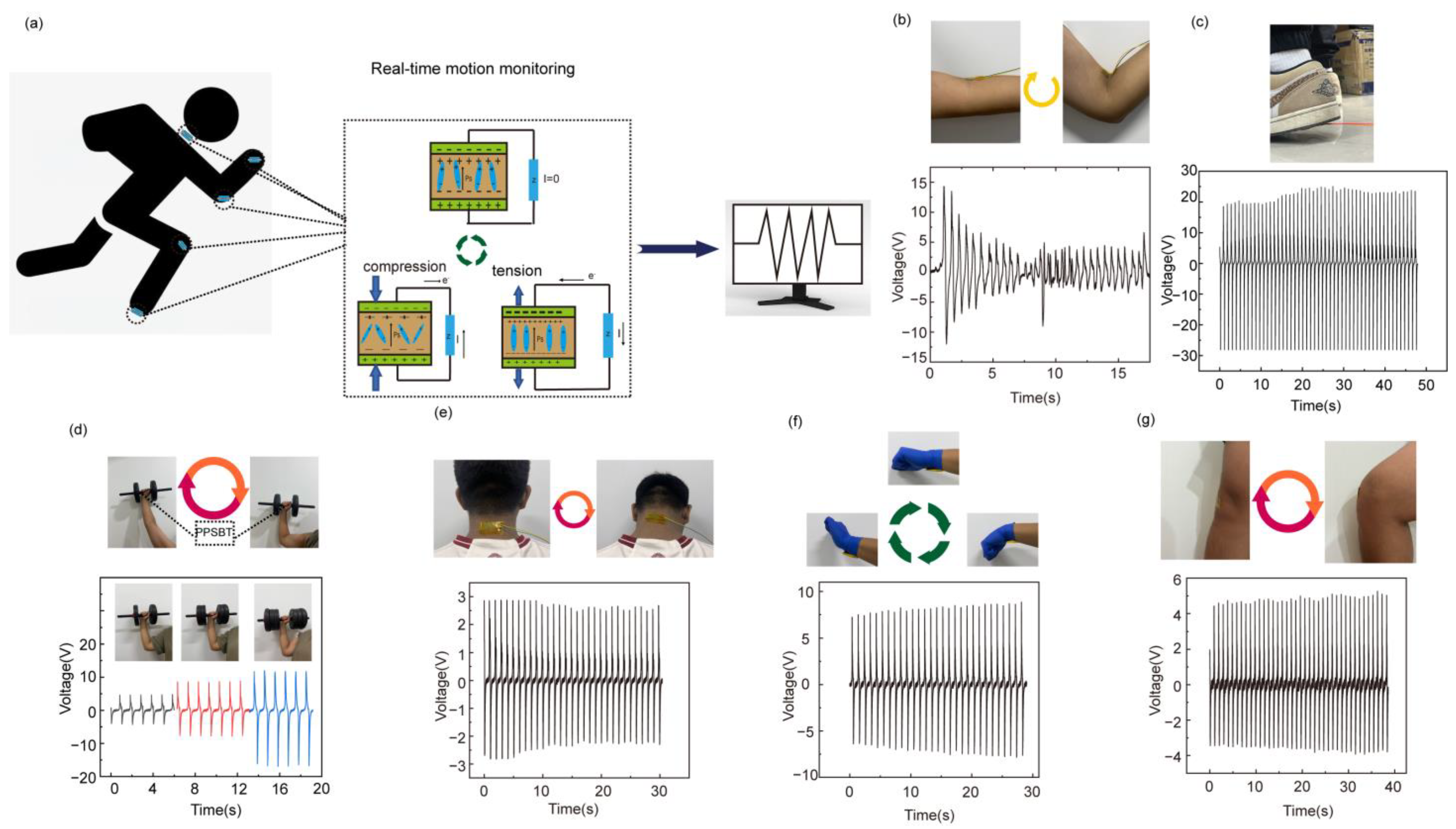
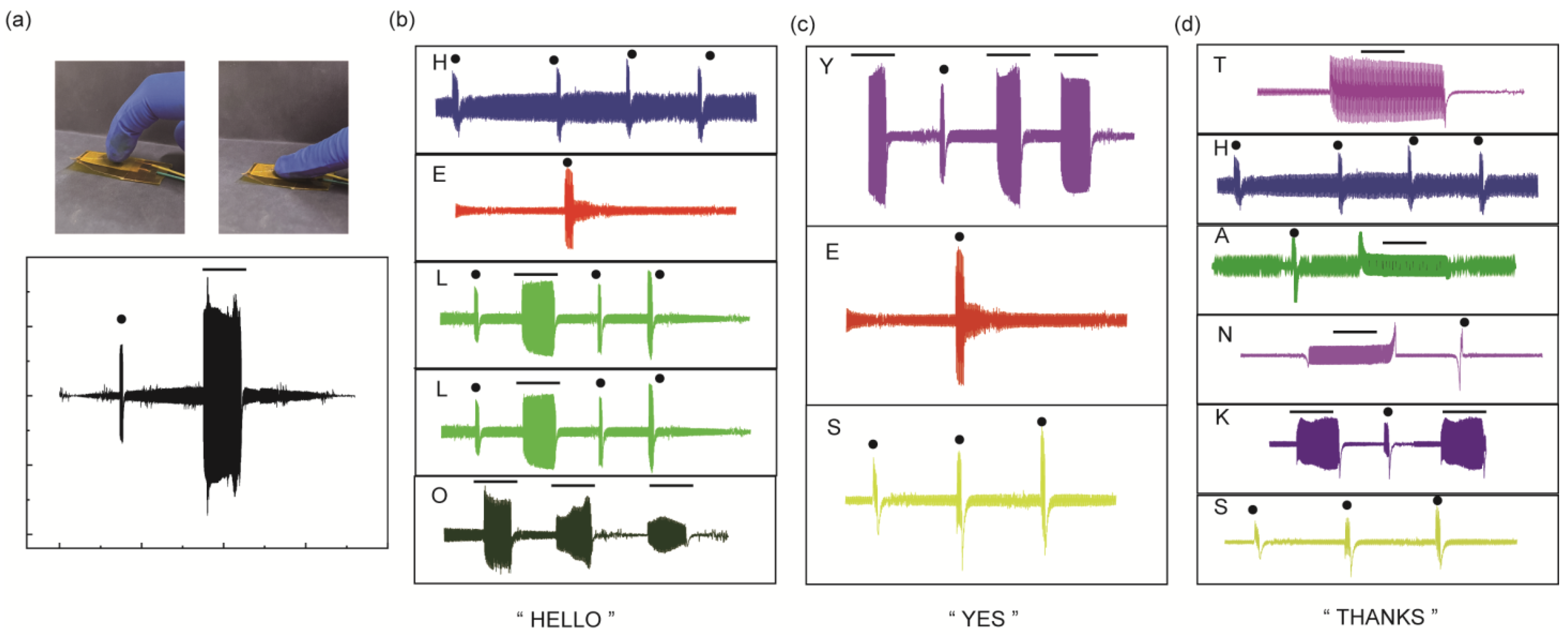
Disclaimer/Publisher’s Note: The statements, opinions and data contained in all publications are solely those of the individual author(s) and contributor(s) and not of MDPI and/or the editor(s). MDPI and/or the editor(s) disclaim responsibility for any injury to people or property resulting from any ideas, methods, instructions or products referred to in the content. |
© 2024 by the authors. Licensee MDPI, Basel, Switzerland. This article is an open access article distributed under the terms and conditions of the Creative Commons Attribution (CC BY) license (https://creativecommons.org/licenses/by/4.0/).
Share and Cite
Sui, X.; Mu, Q.; Li, J.; Zhao, B.; Gu, H.; Yu, H.; Du, J.; Ren, L.; Hu, D. High-Performance Flexible PLA/BTO-Based Pressure Sensor for Motion Monitoring and Human–Computer Interaction. Biosensors 2024, 14, 508. https://doi.org/10.3390/bios14100508
Sui X, Mu Q, Li J, Zhao B, Gu H, Yu H, Du J, Ren L, Hu D. High-Performance Flexible PLA/BTO-Based Pressure Sensor for Motion Monitoring and Human–Computer Interaction. Biosensors. 2024; 14(10):508. https://doi.org/10.3390/bios14100508
Chicago/Turabian StyleSui, Xuguang, Qingmiao Mu, Jia Li, Bo Zhao, Hongxi Gu, Han Yu, Juan Du, Lijun Ren, and Dengwei Hu. 2024. "High-Performance Flexible PLA/BTO-Based Pressure Sensor for Motion Monitoring and Human–Computer Interaction" Biosensors 14, no. 10: 508. https://doi.org/10.3390/bios14100508
APA StyleSui, X., Mu, Q., Li, J., Zhao, B., Gu, H., Yu, H., Du, J., Ren, L., & Hu, D. (2024). High-Performance Flexible PLA/BTO-Based Pressure Sensor for Motion Monitoring and Human–Computer Interaction. Biosensors, 14(10), 508. https://doi.org/10.3390/bios14100508





